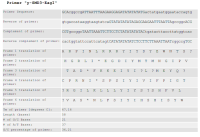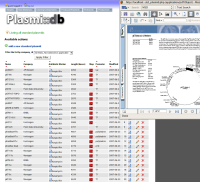Plasmi::db in action
Figure 3.One persistent problem for molecular biologists is the verification of primer sequences.Why did I order these primers anyway? Do they encode the desired sequence? Can I check a set of primers easily? What is its Tm? Using in-line
dynamic 6-frame translation, each primer can be checked at a click of a button.
|
Figure 4.Calculation of stats for a protein is painful."If I add a His-tag and TEV cleavage site to my protein, what will be the molecular weight?" Just enter in the DNA sequence and it will be dynamically translated and its stats calculated....
|
Figure 5.I need primers corresponding to each of the 32 proteins I work on. How can I design them all before I pick up the kids?
Aaagh! I've just bought these primers with NdeI sites in them, and I've got an NdeI site in my gene! I forgot to check the restriction pattern- my boss will kill me! By using a tailor-made primer designer, you can:
|
Figure 6.Standard plasmids are stored in a table, with PDF files listed with them. |
Figure 7.Are you intersted in doing more? The syntax for sequence manipulation is easy, as an improved version of BioPHP |

 Contact developer
Contact developer File a bug or feature request
File a bug or feature request




